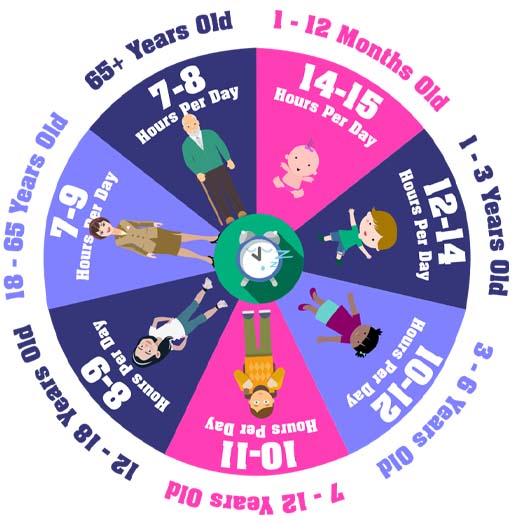3.3 Sleep and mental health
You’ve probably had times when you were unable to sleep and as a result felt tired, grumpy and were unable to concentrate well. Sleep can be particularly important during adolescence. Sleep disruption can exacerbate depression (Baum et al., 2014), and it is widely accepted that good sleep is essential for good mental health. Many young people may report feeling excessively tired when experiencing mental health problems and many parents or caregivers may notice that their child is sleeping a lot or experiencing disrupted sleep.
Before learning more about this, consider how much sleep a young person needs.
Activity 8: Sleep needs in adolescence
a.
4-5 hours
b.
6-7 hours
c.
8-9 hours
d.
10 hours or more
The correct answer is c.
There are some important considerations regarding sleep in adolescence. One is that sleep seems to have an effect on the development of the brain structure in adolescents. It is also understood that restricted or interrupted sleep can affect learning and memory as well as the processing of emotions (Short et al., 2013, Tarokh et al., 2016). There is little doubt that good quality sleep restores the brain, and that the adolescent brain is undergoing significant structural changes. Scientists still have much to learn about the relationship between sleep and the adolescent brain, and this remains an active area of enquiry.
During adolescence, the internal body clock shifts so that a young person tends to go to sleep later at night and wake later in the morning. This shift in body clock tends to disadvantage young people, who find it difficult to wake for school and get to sleep at a good time in the evenings (Crowley et al., 2006).
External factors, such as light, also influence the body clock. Neuroscientists have found that light at the blue end of the spectrum enhances alertness, whereas red light can reduce alertness. Exposure to natural light during the day, which has high levels of blue light, can enhance healthy sleep patterns in young people, and reducing blue light before bedtime can help a young person get to sleep (Studer et al., 2019). There is growing concern over screen use in the bedroom as screens typically emit blue light.
The evidence for the benefits of good sleep is persuasive, so what can you do as a parent or caregiver? The next activity helps to answer this question.
Activity 9: Promoting sleep
a.
strenuous physical exercise in the hour leading to bedtime
b.
using a smartphone, tablet or PC in the hour leading to bedtime
c.
watching TV in the hour leading to bedtime
d.
drinking caffeine, particularly in the 4 hours before bed
The correct answers are a, b, c and d.
a.
reading a book at bedtime
b.
listening to relaxing music
c.
having a bath
d.
change bedroom lightbulbs to ones with a warmer light
e.
write down any worries that are interfering with sleep
f.
aim for at least 60 minutes’ exercise during the day
g.
get outdoors as much as possible while it is light
h.
a good bedtime routine
The correct answers are a, b, c, d, e, f, g and h.
a.
thicker curtains or a blackout blind in the bedroom
b.
using an app to support good ‘sleep hygiene’ (the good habits that facilitate sleep)
The correct answers are a and b.

